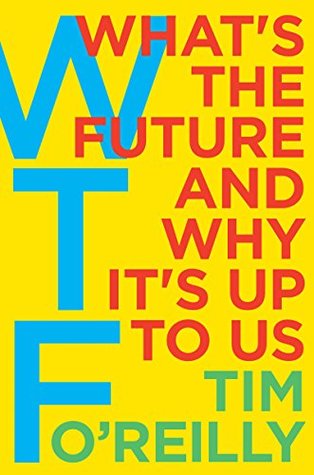More on this book
Community
Kindle Notes & Highlights
by
Tim O'Reilly
Read between
December 19, 2019 - February 28, 2020
So what makes a real unicorn of this amazing kind? 1. It seems unbelievable at first. 2. It changes the way the world works. 3. It results in an ecosystem of new services, jobs, business models, and industries.
This is the rhyming pattern that I noticed: The personal computer industry had begun with an explosion of innovation that broke IBM’s monopoly on the first generation of computing, but had ended in another “winner takes all” monopoly. Look for repeating patterns and ask yourself what the next iteration might be.
It is almost always the case that if you want to see the future, you have to look not at the technologies offered by the mainstream but by the innovators out at the fringes.
The lesson is clear: Treat curiosity and wonder as a guide to the future. That sense of wonder may just mean that those crazy enthusiasts are seeing something that you don’t . . . yet.
This is a key lesson in how to see the future: bring people together who are already living in it. Science fiction writer William Gibson famously observed, “The future is already here. It’s just not evenly distributed yet.” The early developers of Linux and the Internet were already living in a future that was on its way to the wider world. Bringing them together was the first step in redrawing the map.
This is my next lesson. If the future is here, but just not evenly distributed yet, find seeds of that future, study them, and ask yourself how things will be different when they are the new normal. What happens if this trend keeps going?
“When attractive profits disappear at one stage in the value chain because a product becomes modular and commoditized, the opportunity to earn attractive profits with proprietary products will usually emerge at an adjacent stage.”
Real breakthroughs come when an entrepreneur doesn’t just use new technology to duplicate what went before or to fine-tune the way the world works now, but to reimagine how it ought to work.
What do all these forms of regulation have in common? 1. A clear understanding of the desired outcome. 2. Real-time measurement to determine if that outcome is being achieved. 3. Algorithms (i.e., a set of rules) that make continuous adjustments to achieve the outcome. 4. Periodic, deeper analysis of whether the algorithms themselves are correct and performing as expected.
Laws should specify goals, rights, outcomes, authorities, and limits. If specified broadly and clearly, those laws can stand the test of time. Regulations, which specify how to execute those laws in much more detail, should be regarded in much the same way that programmers regard their code and algorithms, that is, as a constantly updated set of tools designed to achieve the outcomes specified in the laws.
Air Force Colonel John Boyd, “the father of the F-16,” introduced the term OODA loop (“Observe-Orient-Decide-Act”) to describe why agility is more important in combat than pure firepower.
Fink makes the case that instead of returning cash to shareholders, companies should be spending far more of their hoarded profits on improving the skills of their workers. “In order to fully reap the benefits of a changing economy—and sustain growth over the long-term—businesses will need to increase the earnings potential of the workers who drive returns, helping the employee who once operated a machine learn to program it,” he writes. They “must improve their capacity for internal training and education to compete for talent in today’s economy and fulfill their responsibilities to their
...more
Since the mid-1980s, Lazonick observes, “the resource-allocation regime at many, if not most, major U.S. business corporations has transitioned from ‘retain-and-reinvest’ to ‘downsize-and-distribute.’ Under retain-and-reinvest, the corporation retains earnings and reinvests them in the productive capabilities embodied in its labor force. Under downsize-and-distribute, the corporation lays off experienced, and often more expensive, workers, and distributes corporate cash to shareholders.”
“The single biggest unexplored reason for long-term slower growth,” she writes, “is that the financial system has stopped serving the real economy and now serves mainly itself.”
By coincidence, the difference between Walmart wages and a $15 minimum wage for their US workers (approximately $5 billion a year) is not that far off from the $6 billion a year that Walmart workers are subsidized via federal Supplemental Nutrition Assistance Program (SNAP, commonly known as food stamps).
It has been estimated that the total public subsidy to low-wage employers amounts to $153 billion per year.
Once companies take money from venture capitalists, they are committed to aiming for an exit. A typical venture fund is a partnership with a ten-year time horizon.
Once an entrepreneur takes money from a venture capitalist, he or she is promising to sell or go public within the lifetime of the fund.
Hank estimates that there are more than 37,000 people who make a full-time living posting to YouTube alone (ranging from those who are barely making a living wage to those pulling down seven figures), and almost 300,000 who make supplemental income.
An experienced software developer today probably needs to up his or her game with regards to tensor calculus in order to work with machine learning algorithms.
Rackspace, based in San Antonio, Texas, proudly showed me Open Cloud Academy, the vocational school his company founded to create the workforce he needs to hire. He told me that Rackspace hires about half of the graduates; the rest go to work in other Internet businesses.
I’ve always loved the judgment of Kurt Vonnegut’s novel Mother Night: “We are what we pretend to be, so we must be careful about what we pretend to be.”
I’ve always thought that the converse of Vonnegut’s admonition is also true: Pretending to be better than we are can be a way of setting the bar higher, not just for ourselves but for those around us.


